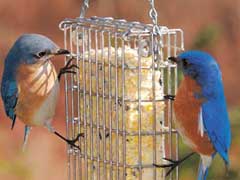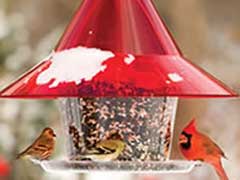 ‘Tis the season to help the songbirds
‘Tis the season to help the songbirds
Cold snaps like we’ve been having (and will continue to have thru February) put life threatening stress on the birds in your garden. It’s their most dangerous time of year. Their summer insect food supply is gone and the days are shorter, so they have to work much harder in less time to find food while burning more calories to stay warm. Plus, an even bigger threat than the lack of food is a lack of water. Our days of daily thunderstorms are long gone and we are surrounded by salt water, which they can’t drink.
You can immediately help all the neighborhood birds by putting in a birdbath or other water source. And, of course, watch out for the water freezing solid in our 25 degree nights. I’ve been pouring hot water on the ice in mine, and within minutes, find it visited by thirsty birds desperate for a drink. The same goes for your plants. What can seem like ‘cold damage’ is really ‘lack-of-water’ damage due to the drying effects of cold winds. I have a camellia whose leaves all looked wilted and dying from the cold, but after a deep watering with the hose, perked right back up. The key is deep watering in the warm part of the day during these dry months.
The best ways to feed birds
Different species of birds feed in different ways. Some birds feed only on the ground, some from  feeding stations, and others prefer the tube feeders. So it’s best to have all three types to help the most birds.
feeding stations, and others prefer the tube feeders. So it’s best to have all three types to help the most birds.
Something as simple as a garbage can top with a hole drilled in it for drainage can work for the ground. Cardinals, for example, love black sunflower seeds on the ground feeder. You have to put it far enough away from bushes where cats can lurk. (It’s best to keep the cat inside during the major feeding times, morning and late afternoon.)
The better tube feeders have either cages over them to keep squirrels out or have a built in battery run spinning device that does the same. By the way, songbirds have a special pouch inside their throat where they store seeds and then slowly digest them all night long to keep their body temperatures up.
Choosing the right seeds
It’s cheaper in the long run to buy large bags of single seeds, vs. mixtures. If you you are shopping for a mixture, check and see if it has red millet; if it does, don’t buy it. Most birds only eat white millet, not red, but companies use the cheaper red as filler to make it seem like you’re getting a lot. But the red just ends up being kicked to the ground.
Here are the best seeds to buy to attract a wide variety of birds:
Black sunflower seeds (cheaper than the grey striped ones and easier for birds to open)
Nyger (a small black seed that the tiny songbirds love, goes in those tube feeders)
Safflower seeds (loved by chickadees, titmice, and woodpeckers plus squirrels don’t like to eat them)
White millet (sparrows, juncos, and mourning doves love it in feeders or scattered on the ground)
shelled peanuts
Create a dried corn diversion feeder in another part of your yard away from the birds and they will stay mostly there. It really works. You can keep large bags of all the above stored in mouse-proof metal trash cans with tops.
Birds aren’t totally vegetarian
Many birds love suet, especially woodpeckers. It replaces the insects killed by the cold and provides energy and warmth. Suet is rendered fat from beef, venison, or pork trimmings. It’s cheap to buy; or you can easily make your own different ‘gourmet’ versions from meat trimmings by running them through a meat grinder or food processor and melting them down with some sort of double boiler set up so that the bottom won’t burn. (You can also use bacon drippings.) You then pour the slightly cooled result over any combo of a range of possible dry items like: kitchen scraps (left over cake, donuts, cookies, pie crusts and stale bread), peanut hearts, crushed dog biscuits, wheat germ, or any of the seeds mentioned above. You then pour into plastic or natural containers like halved coconut shells and then either leave them in them and put those out or pop the cooled and hardened slabs out and hang in an old onion or other netted bag or a store bought cage holder. It should then be placed or hung off the ground (away from mammals) and you can stop putting suet out in late March as the days warm up again.
Different combos of seeds and scraps attract different birds. You can even put suet in big pine cones along with peanut butter, then hang the cone outside.
For the kids at Christmas
A fun project for kids stuck inside on a cold day is to make string garlands of food to drape around outdoor evergreen bushes or trees to create a ‘Christmas tree for the birds’. You can use cheese cubes, popcorn, raisins, peanuts in shell, donuts, or dried fruit, then everyone can watch the birds enjoy their ‘gifts’. (Although it may take a day or two for the birds to find it).
By implementing some or all of the techniques I’ve described, you will be rewarded by a colorful, twittering community of birds whose antics are fascinating to watch. Plus, you’ll be helping our local and overwintering birds survive to happily sing for another year. And don’t worry, if you suddenly run out of food, studies have shown that birds go immediately back to wild foraging. If your yard suddenly goes quiet and empty of birds it’s usually one of three things: A nearby lurking cat, lack of water, or you’ve run out of food. Other than that, happy birding!






